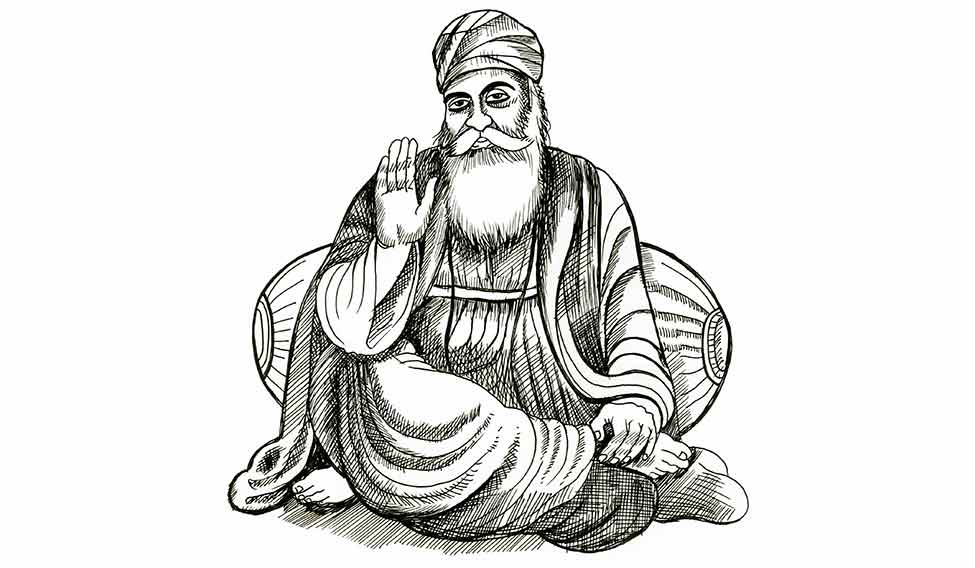
Guru Nanak was born in 1469 in Talwandi village in Sheikhupura district, which is now in Pakistan. As a child, he loved playing with children his age and shared sweets and playthings with them. But, sometimes, Nanak was lost within himself. Throughout his early life as a student, family man, tradesman and accountant, Nanak showed a preference for philosophical discussion and congregational pastimes. And, after a mystic experience, he became an itinerant teacher, travelling not only throughout the subcontinent but also to Mecca, Medina, Baghdad and north Tibet. Thus, he touched the most holy places of Hindus, Muslims and Buddhists. He finally settled on the banks of the river Ravi and institutionalised his teachings in a way that no other Bhakti saint had attempted. He initiated the guru ka langar or 'kitchen of the lord', where everyone, irrespective of birth, ate together from a common vessel. This struck at the core of caste restrictions.
Guru Nanak acquired some knowledge of Punjabi, Hindi and Persian but he had no deep desire for traditional learning. He longed for the truth and travelled extensively.Kabir’s teachings had a profound impact on Nanak’s thinking and, like Kabir, he, too, rejected asceticism. His teachings were direct and simple and he strongly condemned the superstitions of both Hindus and Muslims. He attacked the caste system and said it was against the will of God. He explicitly preached that “religion lies not in empty words and he who regards all men as equal is religious”. He stood for the essential integrity of humanity and was determined to keep himself above the religious differences of Hindus and Muslims.
Guru Nanak’s Janamsakhis (life accounts) say that the first words he uttered after his revelation were: “There is no Hindu, there is no Musalman”. The Janamsakhis, written in the Gurmukhi script, represent the earliest extant models of prose in the language.
The earliest known account of Guru Nanak in a non-Sikh source came a century after him. It was Dabestan-e-Mazaheb, a remarkable and rare book in Persian on the religion and manners of different races. In this work, Sikhs are referred to as Nanak Panthin (those who follow Nanak’s path).
With the passage of time, Sikhism became a fully fledged religion with its own diviner (Guru Nanak), a holy book (the Adi Granth, which later became Guru Granth Sahib) and a house of worship (the gurudwara). Nanak’s pure life, humility and forbearance won him many Hindu and Muslim disciples. According to Nanak, spiritual salvation does not require rigorous austerities or withdrawal from the world. Rather, purity is to be sought in daily life through the word.
Apart from his spiritual and Bhakti contribution, it is also important to mention Nanak’s observation on political tyranny. He once said: “The rajas prey upon the raiyat (peasants) like lions and their muqadams (officials) act like dogs. Royal agents inflict wounds with claws of power and the dogs lick the blood and relish the liver.” Let it be clarified that he was not against the structure of political power but only against the actions of some of the holders of power.
In the 15th century, Guru Nanak sought to improve the condition of women. He said: “From woman, man is born; within woman, man is conceived; to woman he is engaged and married. Woman becomes his friend; through woman, the future generations come. When his woman dies, he seeks another woman; to woman he is bound. So why call her bad?" These words are a source of strength for those fighting for women's rights even today.
Guru Nanak’s uncompromising monotheism, his religious vocabulary drawn from Sanskrit and Arabic traditions, his two closest companions (a Muslim and a Hindu), his relations with religious teachers and his teachings interpose him between Hinduism and Islam. Not as a broker, but as one who clarifies how the rituals of each fall short of the truth. Baba Nanak shah fakir, Hindu ka guru Musalmaan ka peer (Nanak the holy man is the guru of the Hindus and the spiritual teacher of the Muslims).
He offers a path of salvation which encompasses and transcends both. Central to this path is the role of the guru, both as the inner voice of God in man and as the external teacher showing the way to truth.
Syed Mubin Zehra is a historian, social analyst and columnist.
Bhakti movement
God, without middlemen
Bhakti is important as a continuous movement from the 7th to the 16th century in south India, which spread throughout the subcontinent in several parallel streams. While various dynasties offered support and patronage to particular Bhakti groups, some rulers attempted to suppress them. Some common features among the many streams gave Bhakti the force of a populist socio-cultural movement, moulding the history of medieval India.
Shankaracharya (788-820) laid emphasis on strict monotheism and propagated the teachings of the Vedas. Vallabha Acharya (1479-1531), born in a Telugu Brahmin family, tried to simplify Hinduism by rejecting many rituals and ceremonies. Others made vigorous attempts to reform the religious and social aspects of society. They believed in a direct way of reaching God through Bhakti (devotion), without the help of priests. Their all-out attack on the caste system made them very popular among the lower sections of society. The most popular of the Bhakti saints were Kabir and Nanak and, with their advent, the movement touched new heights.
Kabir stands out among the Bhakti saints as a leader of all Bhakti thoughts and philosophy. His salty poems poking fun at pundits and qazis have been on the lips of the common people for more than 500 years now.
The Bhakti cult recognised the dignity of man and denounced all class and caste distinctions and social tyranny rampant in the name of religion.





